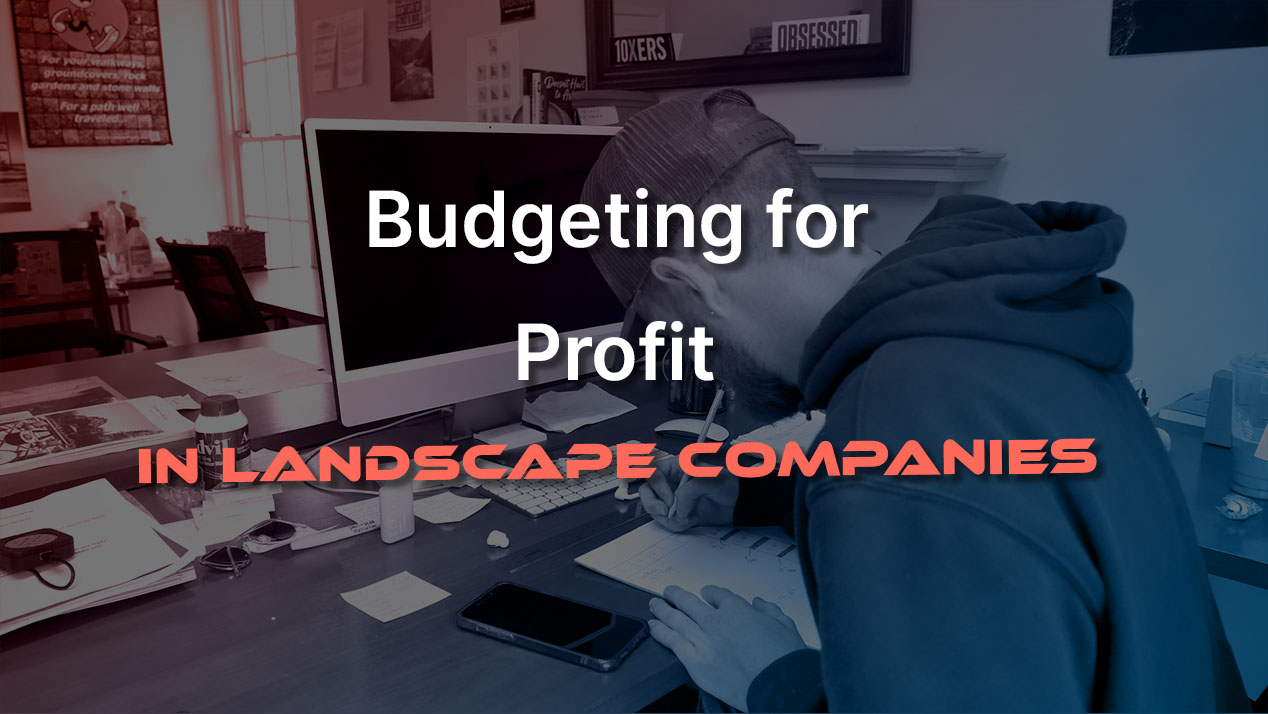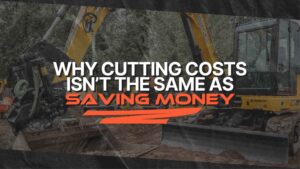Budgeting for Profit in Landscape Companies

We all want a business that makes a profit
As contractors and entrepreneurs, we all want to be successful and have a business that makes a profit but that doesn’t own us.
So… how do we become or build that ever-elusive business “we wanna be”?
Well…. pragmatically speaking, it at minimum takes cash.
Without cash, all chances of “success” (whatever that looks like to you) slip through your fingers like sand.
More specifically, I’m not just talking about cash. I’m referring to cash in the profit bucket.
The cash that is left after there are no more bills left to pay.
So, for the rest of this article, I’m going to focus on how to generate just that.
Cash that is in the profit bucket.
How do you price your work in such a way that when your customer pays you for the work completed, and you cover your costs to do the work, there is profit, cash, left over?
Enough cash to fuel your ambitions for success.
Enough that the business can pay for the systems and processes, equipment, and staff needed to free you from the entrepreneurial prison.
Meaning the business doesn’t own you.
So, let’s get into it.
Make sure you are pricing jobs correctly
First, we need to make sure you are pricing your jobs correctly.
If they aren’t priced correctly, we’ll certainly have issues earning a profit.
To price them correctly, we need to establish our pricing by building a budget.
I’ve written an in-depth article on just what it means to build a budget here.
This is what building a budget looks like.
But the real thrust of my article today is to budget for the business you want to be tomorrow, not the business you were yesterday.
This little hack is my favorite thing ever about budgeting. It’s awesome! It gives you “permission” to invest into your business, and spend money, in a way that you may have felt was out of reach.
How?
Here’s what I mean:
When plugging in all your expenses and costs into your budget, the theme is
- look at what you spent on that thing (fuel, insurance, etc) last year
- project what you think you’ll spend on that thing this year.
- plug that new “projected” and “forward-looking” number into your budget.
example:
- I spent $12k on fuel last year
- I plan on adding a truck, and possibly driving further to jobs this year, so I’ll bump it up and project that I’ll spend $16k on fuel this year
- I plug $16k into my budget for fuel and move on to the next item
The fun part
Now, pull out your wishlist.
Wish you could hire an office admin to take some load off of you? Let’s just throw that expense into the budget now! Not later when we actually hire them.
Wish you could upgrade your truck? Throw it in the budget!
Wish you could buy that tilt rotator? Put it in the budget!
Wish you could actually make a profit and pay yourself more? Put it in the budget!
Wish you could buy SynkedUP to make this all easier? (haha 😎) Put it in the budget!
When using SynkedUP, all your quotes’ pricing is based on your budget. This means the quote will be priced and marked up perfectly to cover all of the expenses in your budget.
See where I’m going with this?
If you put your “wishlist” into your budget, all your quotes will be priced at rates that produce the funds to pay for your wishlist.
If you can still sell the job at that price, the market has just smiled at you and given you permission to go spend that money on your wishlist!
If you get too carried away with your wishlist, and now prices are so high that you keep getting “no’s” on all your quotes, well, we can go take expenses out of the budget to bring pricing back to a place where the market will bear the burden and still allow you to sell.
The budget dictates your pricing “floor”.
The market dictates the “ceiling”.
You can never sell a job for less than what your budget says. If you do, what was supposed to be your profit, goes to pay for those expenses that weren’t accounted for in the budget.
You can always charge more. As long as you can sell the job, the market is bearing the burden and giving you “permission” to pay for all those expenses in your budget, while still earning a profit.
Both non-wishlist expenses and wishlist expenses.
Build your budget
So, go build a budget, and throw all your non-wishlist expenses in first.
Once you’ve done that, start dreaming and add a couple of wishlist items.
Now, don’t let your head trash and doubt get in the way. Just price a job based on that budget, and hit “Send” on that proposal. You’ll be surprised how often the client responds by signing and paying a down payment.
Price is usually not the biggest factor in closing a job anyway. So let’s just get over it, haha and make a profit!
The main point of this article is to enter anticipated expenses into your budget as soon as you think you’ll need to add them in the near future.
Don’t wait until you’ve actually SPENT the money to put it into the budget.
Put it in the budget now, so that your very next job is priced to produce the funds to pay for that anticipated (wishlist) expense.
Start producing the funds to pay for that expense in cash. Start creating a pool of cash for this stuff.
Want to explore?
If you want to play with the numbers a bit and explore what this would look like for your business; I made a free budgeting tool available to anyone, even if you don’t use SynkedUP.
AND… if you’d like to dig in and then want to have an expert look over your shoulder at your budget, schedule a free budget call with our team! We’ll sanity-check it with you.
If you do use SynkedUP, and want to dig into this and review your budget inside the software, book a call with our experts! (only for active SynkedUP users)
Have you ever done a wishlist budget? How’d it go for you?
Drop a reply or comment here and leave me your thoughts or questions. Can’t wait to hear how it goes for you!
Cheers
Weston

Weston Zimmerman
CEO and co-founder
See SynkedUP in action
Related Articles
What is the Most Difficult Challenge You’ve Overcome?
Cutting costs isn't the same as saving money. Learn how to use leverage, not panic, to drive real profit and...
Why Time Tracking is Critical for Contractors
Cutting costs isn't the same as saving money. Learn how to use leverage, not panic, to drive real profit and...
Why Cutting Costs Isn’t the Same as Saving Money
Cutting costs isn't the same as saving money. Learn how to use leverage, not panic, to drive real profit and...
Slow Down to Speed Up
A quick leadership gut check: Are you building what really matters? Slow down, realign, and lead with intention.
The One Calculation Every Contractor Should Know
Contractors: If you’re not factoring in overhead, you're not pricing right. Learn how to calculate breakeven and stop guessing your...
What Owns Your Day? Urgency or Importance?
Stuck in a cycle of chaos and urgent tasks? Break the cycle with better systems, clear processes, and leadership that...
Taking Care of Your Team
Leadership isn't barking orders - it's listening, appreciating, and building problem solvers. Here's how to lead without burning out.
The Cost of Avoiding Issues in Your Business
Avoiding stuff in business adds up, with interest. Don't try harder, build systems that make success default. Do hard things,...
Leveraging Your Job Data for More Accurate Estimates
Stop estimating from the gut. Track time, collect job data, and turn it into faster, more accurate production rates.
How the Best Contractors Ensure Profitability
Running over estimated hours is one of the biggest silent profit killers in contracting. Here's how to track it, catch...









